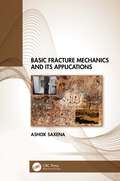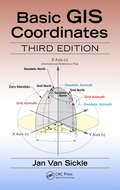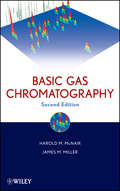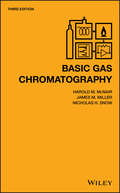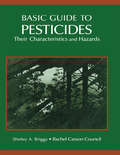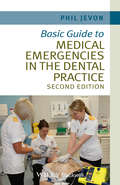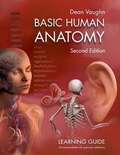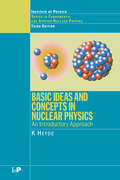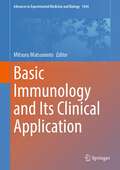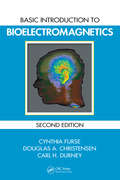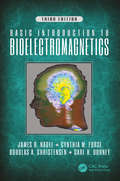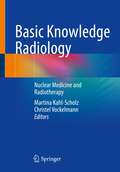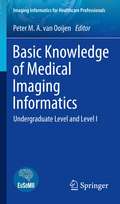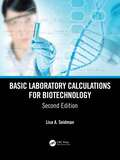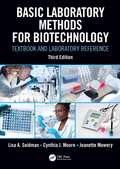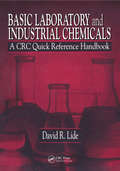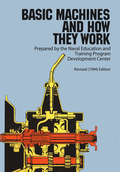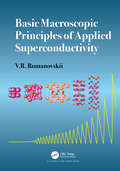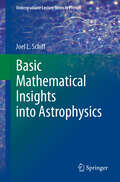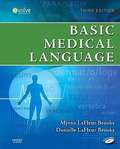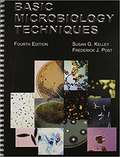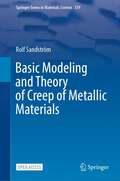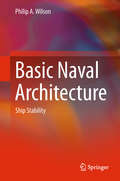- Table View
- List View
Basic Fracture Mechanics and its Applications
by Ashok SaxenaThis textbook provides a comprehensive guide to fracture mechanics and its applications, providing an in-depth discussion of linear elastic fracture mechanics and a brief introduction to nonlinear fracture mechanics. It is an essential companion to the study of several disciplines such as aerospace, biomedical, civil, materials and mechanical engineering. This interdisciplinary textbook is also useful for professionals in several industries dealing with design and manufacturing of engineering materials and structures. Beginning with four foundational chapters, discussing the theory in depth, the book also presents specific aspects of how fracture mechanics is used to address fatigue crack growth, environment assisted cracking, and creep and creep-fatigue crack growth. Other topics include mixed-mode fracture and materials testing and selection for damage tolerant design, alongside in-depth discussions of ensuring structural integrity of components through real-world examples. There is a strong focus throughout the book on the practical applications of fracture mechanics. It provides a clear description of the theoretical aspects of fracture mechanics and also its limitations. Appendices provide additional background to ensure a comprehensive understanding and every chapter includes solved example problems and unsolved end of chapter problems. Additional instructor support materials are also available.
Basic GIS Coordinates
by Jan Van SickleCoordinates are integral building tools for GIS, cartography, surveying and are vital to the many applications we use today such as smart phones, car navigation systems and driverless cars. Basic GIS Coordinates, Third Edition grants readers with a solid understanding of coordinates and coordinate systems and how they operate as well as valuable insight into what causes them to malfunction. This practical and comprehensive guide lays out the foundation of a coordinate system and the implications behind building it as it elaborates on heights, two coordinate systems, and the rectangular system.The previous editions described horizontal and vertical datums such as the North American Datum 1983 (NAD 83) and the North American Vertical Datum 1988 (NAVD 88). Both will be replaced in 2022 or thereabouts. The National Geodetic Survey (NGS) plans to replace NAD83 with a new semi-dynamic terrestrial reference frame for North America and a new vertical datum will replace NAVD88. The foundation of the new vertical datum will be a temporally tracked gravimetric geoid. The interim period is intended to smooth the transition to the new paradigm and this new edition explores the changes and provides assistance in understanding them.
Basic Gas Chromatography
by Harold M. Mcnair James M. MillerThe New Edition of the Well-Regarded Handbook on Gas ChromatographySince the publication of the highly successful first edition of Basic Gas Chromatography, the practice of chromatography has undergone several notable developments. Basic Gas Chromatography, Second Edition covers the latest in the field, giving readers the most up-to-date guide available, while maintaining the first edition's practical, applied approach to the subject and its accessibility to a wide range of readers.The text provides comprehensive coverage of basic topics in the field, such as stationary phases, packed columns and inlets, capillary columns and inlets, detectors, and qualitative and quantitative analysis. At the same time, the coverage also features key additions and updated topics including:Gas chromatography-mass spectrometry (GC-MS)Sampling methodsMultidimensional gas chromatographyFast gas chromatographyGas chromatography analysis of nonvolatile compoundsInverse gas chromatography and pyrolysis gas chromatographyAlong with these new and updated topics, the references, resources, and Web sites in Basic Gas Chromatography have been revised to reflect the state of the field. Concise and fundamental in its coverage, Basic Gas Chromatography, Second Edition remains the standard handbook for everyone from undergraduates studying analytical chemistry to working industrial chemists.
Basic Gas Chromatography (Techniques In Analytical Chemistry Ser.)
by James M. Miller Harold M. McNair Nicholas H. SnowBasic Gas Chromatography, Third Edition provides a brief introduction to GC following the objectives for titles in this series. It should appeal to readers with varying levels of education and emphasizes a practical, applied approach to the subject. : This book provides a quick need-to-know introduction to gas chromatography; still the most widely used instrumental analysis technique, and is intended to assist new users in gaining understanding quickly and as a quick reference for experienced users. The new edition provides updated chapters that reflect changes in technology and methodology, especially sample preparation, detectors and multidimensional chromatography. The book also covers new detectors recently introduced and sample preparation methods that have become much more easily accessible since the previous edition.
Basic Guide To Pesticides: Their Characteristics & Hazards
by Rachel Carson Counsel Inc.This work contains physical properties of over 700 pesticides and transformation products and contaminants. It can be used by the layman with minor questions or by the specialist needing in-depth references. Facts have been arranged so that one does not have to read through lengthy material.
Basic Guide to Medical Emergencies in the Dental Practice
by Philip JevonThe Basic Guide to Medical Emergencies in the Dental Practice is a must-have book for all dental care professionals and general dentists.Written in a clear and accessible style, this second edition has been fully revised and updated in line with the latest guidelines. Chapters cover such key topics as the ABCDE approach to patient assessment, resuscitation equipment, respiratory and cardiac disorders, paediatric emergencies, and legal and ethical issues. Readers will also find two brand new chapters on the principles of first aid, and drugs for medical emergencies.Follows Resuscitation Council (UK) GuidelinesCompanion website with self-assessment exercises, serving as revision as well as non-verifiable CPD creditOver 50% new imagesStudent friendly colourful layout with learning outcomes
Basic Human Anatomy Learning Guide
by Dean VaughnThis unique instructional system was developed by Dean Vaughn, who is recognized as the foremost authority in applied memory technology for learning. His instructional systems are used throughout the world in thousands of the finest academic, health, and business institutions with unprecedented success. This proven system of mnemonic instruction and learning has been acclaimed by educators as one of the most significant breakthroughs in education today. As a student of basic human anatomy, you are fortunate to have the opportunity to use this organized system of applied memory techniques to learn the subject. It will teach you not only how to learn but also how to remember what you learn!
Basic ICS-10-CM & ICD-10-PCS Coding
by Lou Ann Schraffenberger Brooke N. PalkieThe coding process requires a range of skills that combine knowledge and practice. Basic ICD-10-CM and ICD-10-PCS Coding was designed to be a comprehensive text for students. It introduces the basic principles and conventions of ICD-10-CM and ICD-10-PCS coding and illustrates the application of coding principles with examples and exercises based on actual case documentation.
Basic Ideas and Concepts in Nuclear Physics: An Introductory Approach, Third Edition
by K HeydeThe third edition of a classic book, Basic Ideas and Concepts in Nuclear Physics sets out in a clear and consistent manner the various elements of nuclear physics. Divided into four main parts: the constituents and characteristics of the nucleus; nuclear interactions, including the strong, weak and electromagnetic forces; an introduction to nuclear structure; and recent developments in nuclear structure research, the book delivers a balanced account of both theoretical and experimental nuclear physics for students studying the topic. In addition to the numerous revisions and updates to the previous edition to capture the developments in the subject over the last five years, the book contains a new chapter on the structure and stability of very light nuclei. As with the previous edition the author retains a comprehensive set of problems and the book contains an extensive and well-chosen set of diagrams. He keeps the book up to date with recent experimental and theoretical research, provides mathematical details as and when necessary, and illustrates topics with box features containing examples of recent experimental and theoretical research results.
Basic Immunology and Its Clinical Application (Advances in Experimental Medicine and Biology #1444)
by Mitsuru MatsumotoThis book overviews ongoing and upcoming clinical applications of basic immunology. Recent advances in our knowledge of immunology coupled with new technologies have aided in the development of efficient cancer immunotherapy, as well as the control of emerging microorganisms such as SARS-CoV-2. However, knowledge of basic immunology has not been fully utilized even after the discoveries of immune checkpoint inhibition for cancer immunotherapy and the development of mRNA vaccination against SARS-CoV-2. There is still room for improving the clinical application of basic immunology. The book summarizes the achievements in clinical applications of basic immunology and highlights what can be further extended to make immunology a more practical human science. Basic immunology and its clinical applications are two wheels of the same cart in the immunology field, which aids in the development of more efficient cancer immunotherapy and rapid control of infectious diseases against microorganisms, including new viruses and classical toxoplasmosis. The exploration of ongoing and upcoming applications of basic immunology in this book makes it a useful resource for immunologists, physicians, molecular and genome biologists, bioinformaticians, and students in these fields.
Basic Introduction to Bioelectromagnetics
by Cynthia Furse Douglas A. Christensen Carl H. DurneyAlthough classical electromagnetic (EM) field theory is typically embedded in vector calculus and differential equations, many of the basic concepts and characteristics can be understood with precursory mathematical knowledge. Completely revised and updated, Basic Introduction to Bioelectromagnetics, Second Edition facilitates the process of interd
Basic Introduction to Bioelectromagnetics, Third Edition
by James Nagel Cynthia Furse Douglas A. Christensen Carl H. DurneyBasic Introduction to Bioelectromagnetics, Third Edition, is a primary source for medical technologists and life scientists seeking to understand how electromagnetic fields interact with the body, and how they are used in medical applications. Instead of the complex math commonly used when analyzing electromagnetics, this book uses graphical methods and simple equations. The third edition is updated with color graphics that show the fields in bright, clear colors. Each concept is presented with an associated discussion and application, including MRI, NMR, hyperthermia, neural stimulation, ultrasound, and cardiac pacing/defibrillation. Offering a simplified explanation of a very complex subject, this third edition provides an accessible introduction for life scientists and medical technologist on how EM fields work, what controls them, and the factors important to experimental setups and medical applications. This qualitative and illustrative book: Covers the entire frequency spectrum from direct current (DC) up through optical frequencies. Includes more than 200 illustrations, 65 in color, and 40 medical applications. Incorporates examples from real-world applications to explain concepts. Concentrates on the qualitative explanation of the key concepts, fundamental principles, and characteristic behaviors of EM fields, without complicated mathematics. Offers practical rules of thumb to understand real situations. Requires only a background in algebra, in contrast to typical EM books that require vector calculus and differential equations.
Basic Knowledge Radiology: Nuclear Medicine and Radiotherapy With 215 Illustrations
by Martina Kahl-Scholz Christel VockelmannClear and compact, this textbook provides you with a complete overview of all radiology content relevant to the exam. It guides you in an easy-to-understand and GK-oriented manner through the entire basic knowledge from the fundamentals to the most important clinical pictures, including nuclear medicine and radiation therapy. Benefit from the many years of experience of the lecturers, who have carefully selected and prepared the essentials for you.
Basic Knowledge of Medical Imaging Informatics: Undergraduate Level and Level I (Imaging Informatics for Healthcare Professionals)
by Peter M. A. van OoijenThis book provides a unique introduction to the vast field of Medical Imaging Informatics for students and physicians by depicting the basics of the different areas in Radiology Informatics. It features short chapters on the different main areas in Medical Imaging Informatics, such as Picture Archiving and Communication Systems (PACS), radiology reporting, data sharing, and de-identification and anonymization, as well as standards like Digital Imaging and Communications in Medicine (DICOM), Integrating the Health Enterprise (IHE) and Health Level 7 (HL7,. Written by experts in the respective fields and endorsed by the European Society of Medical Imaging Informatics (EuSoMII) the scope of the book is based on the Medical Imaging Informatics sub-sections of the European Society of Radiology (ESR) European Training Curriculum Undergraduate Level and Level I. This volume will be an invaluable resource for residents and radiologists and is also specifically suited for undergraduate training.
Basic Laboratory Calculations for Biotechnology
by Lisa A. SeidmanTo succeed in the lab, it is crucial to be comfortable with the math calculations that are part of everyday work. This accessible introduction to common laboratory techniques focuses on the basics, helping even readers with good math skills to practice the most frequently encountered types of problems. Basic Laboratory Calculations for Biotechnology, Second Edition discusses very common laboratory problems, all applied to real situations. It explores multiple strategies for solving problems for a better understanding of the underlying math. Primarily organized around laboratory applications, the book begins with more general topics and moves into more specific biotechnology laboratory techniques at the end. This book features hundreds of practice problems, all with solutions and many with boxed, complete explanations; plus hundreds of "story problems" relating to real situations in the lab. Additional features include: Discusses common laboratory problems with all material applied to real situations Presents multiple strategies for solving problems help students to better understand the underlying math Provides hundreds of practice problems and their solutions Enables students to complete the material in a self-paced course structure with little teacher assistance Includes hundreds of "story problems"that relate to real situations encountered in the laboratory
Basic Laboratory Methods for Biotechnology: Textbook and Laboratory Reference
by Lisa A. Seidman Cynthia J. Moore Jeanette MoweryBasic Laboratory Methods for Biotechnology, Third Edition is a versatile textbook that provides students with a solid foundation to pursue employment in the biotech industry and can later serve as a practical reference to ensure success at each stage in their career. The authors focus on basic principles and methods while skillfully including recent innovations and industry trends throughout. Fundamental laboratory skills are emphasized, and boxed content provides step by step laboratory method instructions for ease of reference at any point in the students’ progress. Worked through examples and practice problems and solutions assist student comprehension. Coverage includes safety practices and instructions on using common laboratory instruments. Key Features: Provides a valuable reference for laboratory professionals at all stages of their careers. Focuses on basic principles and methods to provide students with the knowledge needed to begin a career in the Biotechnology industry. Describes fundamental laboratory skills. Includes laboratory scenario-based questions that require students to write or discuss their answers to ensure they have mastered the chapter content. Updates reflect recent innovations and regulatory requirements to ensure students stay up to date. Tables, a detailed glossary, practice problems and solutions, case studies and anecdotes provide students with the tools needed to master the content.
Basic Laboratory and Industrial Chemicals: A CRC Quick Reference Handbook
by David R. LideBasic Laboratory and Industrial Chemicals presents data on 1,000 high-profile chemical substances commonly used in the laboratory and workplace. A wide range of properties is provided for each compound, including the basic physical properties, such as melting point, boiling point, and critical temperature; density; transition properties, such as vapor pressure and heats of vaporization and fusion; and thermodynamic properties, viscosity, and thermal conductivity at 25 degrees centigrade.
Basic Machines and How They Work
by Naval EducationThis revised edition of an extremely clear Navy training manual leaves nothing to be desired in its presentation. Thorough in its coverage of basic theory, from the lever and inclined plane to internal combustion engines and power trains, it requires nothing more than an understanding of the most elementary mathematics. Beginning with the simplest of machines — the lever — the text proceeds to discussions of the block and tackle (pulleys and hoists), wheel and axle, the inclined plane and the wedge, the screw, and different types of gears (simple, spur, bevel, herringbone, spiral, worm, etc.). A chapter on the concept of work discusses the measurement of work, friction, and efficiency; this is followed by investigations of power, force, and pressure, with explanations of the uses of scales, balances, gauges, and barometers. The fundamentals of hydrostatic and hydraulic machines (such as the hydraulic braking system and the hydraulic press) are discussed in detail. The remaining chapters cover machine elements (bearings and springs), basic mechanisms (gear differential, couplings, cams, clutches), the internal combustion engine and power trains (including explanations of various transmission systems — synchromesh, auxiliary, etc.). Every concept is clearly defined, and discussions always build easily from elementary theory to specific applications familiar to anyone with the slightest interest in mechanics. Important concepts, machine components, and techniques are clearly illustrated in more than 200 diagrams, drawings, and cross-sections that reveal inner workings — all of these help to clarify even further an already clear and well-organized presentation. Although it was originally designed for use in U.S. Naval Training Schools, this book can be used to great advantage as a basic text in mechanical engineering in standard technical schools, and it will be immensely valuable even to lay readers who desire a basic knowledge of mechanics.
Basic Macroscopic Principles of Applied Superconductivity
by V.R. RomanovskiiThis book is on applied superconductivity, which is one of the topical issues of modern science and technology. At present, the prospects for the practical application of superconductivity are obvious from both economic and practical points of view. It can reduce heat losses and reduce the weight and size of equipment, improve the reliability of electrical devices and power systems, and create new devices. As a result, the achievements of applied superconductivity make it possible to perform effective retrofitting of equipment for scientific research, in medicine, electric power, electrical engineering, transport, and to introduce new advanced technologies that provide higher efficiency, significantly reducing working costs.
Basic Mathematical Insights into Astrophysics (Undergraduate Lecture Notes in Physics)
by Joel L. SchiffThis book will show how it is possible to explore the Universe not only with telescopes but also with Mathematics. Moreover, this book aims at explaining the equations governing the behavior of the stars, planets, and galaxies, which are very accessible to the average undergraduate who has studied some Mathematics in school. We will also probe into unseen black holes to determine their mass as well as investigate other intriguing celestial phenomena such as dark matter and dark energy, the expansion of the Universe, and explore via Einstein’s Theory of Relativity, the very foundations of space and time itself. You will discover that both Special and General Relativity are absolutely essential for the functioning of the Global Positioning System (GPS), which illustrates how astrophysical ideas can impact everyday lives. Lastly, this book provides insight into how Mathematics allows us to see and hear how the Universe ticks. Each chapter is a front row seat for those who wish to listen to some of the most beautiful music expressed by the Universe, Mathematics.
Basic Medical Language (Third Edition)
by Myrna Lafleur Brooks Danielle Lafleur BrooksFocused on the basic word analysis skills you need for medical terminology, Basic Medical Language, 3rd Edition includes a carefully selected group of suffixes, prefixes, and word roots to give you a foundation for recognizing and communicating medical terms. A combination of body system lessons, anatomy presentations, and introductions to word parts reinforce basic word building skills. Plus, you can take charge of your learning with the companion CD packaged with the text and an online audio program for additional practice. Beginning with word parts and moving on to whole words, the systematic presentation equips you to recognize and define new words as you encounter them. A variety of learning exercises tests your knowledge and provides instant feedback on your progress. The Abbreviations tables include the most common medical abbreviations you'll encounter in the healthcare setting. Review sections within each lesson reinforce your learning. Consistent organization and pacing of lessons steadily build your knowledge and vocabulary. Coverage of every body system ensures you have all the basic medical terminology content you need. FYI boxes include practical and interesting information to spark your curiosity. Over 200 flash cards printed on card stock and bound with the book provide a portable way to study. At-a-Glance sections provide a quick review to help you get the most out of each lesson. New illustrations and diagnostic images show the latest developments in the clinical environment. Exercises like Interact with Medical Documents and others help you understand and use terms with the documents you'll use in practice. Outline/Objectives highlight the most important information for each chapter. Icons throughout the text direct you to the companion CD to enhance your learning experience. Two new games, updated activities, and animations on the companion CD reinforce your learning and provide additional background for pathologies and procedures in the text. The online audio program ensures proper pronunciation of terms.
Basic Microbiology Techniques
by Susan Kelley Frederick PostFrom fundamentals to advanced topics covered in 48 creative, diverse experiments. The authors offer medical, clinical, academic, research, and industrial perspectives. Students and instructors praise the clarity of the presentations. Carefully illustrated procedures present the laboratory exercises clearly and succinctly.
Basic Modeling and Theory of Creep of Metallic Materials (Springer Series in Materials Science #339)
by Rolf SandströmThis open access book features an in-depth exploration of the intricate creep behavior exhibited by metallic materials, with a specific focus on elucidating the underlying mechanical properties governing their response at elevated temperatures, particularly in the context of polycrystalline alloys. Traditional approaches to characterizing mechanical properties have historically relied upon empirical models replete with numerous adjustable parameters, painstakingly tuned to match experimental data. While these methods offer practical simplicity, they often yield outcomes that defy meaningful extrapolation and application to novel systems, invariably necessitating the recalibration of parameters afresh.In stark contrast, this book compiles a compendium of models sourced from the scientific literature, meticulously crafted through ab initio methodologies rooted in fundamental physical principles. Notably, these models stand apart by their conspicuous absence of adjustable parameters. This pioneering effort is envisioned as a groundbreaking initiative, marking the first of its kind in the field. The resulting models, bereft of arbitrary tuning, offer a level of predictability hitherto unattained. Notably, they provide a secure foundation for ascertaining operational mechanisms, contributing significantly to enhancing our understanding of material behavior in high-temperature environments.This open access book is a valuable resource for researchers and seasoned students engaged in the study of creep phenomena in metallic materials. Readers will find a comprehensive exposition of these novel, parameter-free models, facilitating a deeper comprehension of the intricate mechanics governing material deformation at elevated temperatures.
Basic Molecular Quantum Mechanics
by Steven A. AdelmanQuantum mechanics is a general theory of the motions, structures, properties, and behaviors of particles of atomic and subatomic dimensions. While quantum mechanics was created in the first third of the twentieth century by a handful of theoretical physicists working on a limited number of problems, it has further developed and is now applied by a great number of people working on a vast range of problems in wide areas of science and technology. Basic Molecular Quantum Mechanics introduces quantum mechanics by covering the fundamentals of quantum mechanics and some of its most important chemical applications: vibrational and rotational spectroscopy and electronic structure of atoms and molecules. Thoughtfully organized, the author builds up quantum mechanics systematically with each chapter preparing the student for the more advanced chapters and complex applications. Additional features include the following: This book presents rigorous and precise explanations of quantum mechanics and mathematical proofs. It contains qualitative discussions of key concepts with mathematics presented in the appendices. It provides problems and solutions at the end of each chapter to encourage understanding and application. This book is carefully written to emphasize its applications to chemistry and is a valuable resource for advanced undergraduates and beginning graduate students specializing in chemistry, in related fields such as chemical engineering and materials science, and in some areas of biology.
Basic Naval Architecture: Ship Stability
by Philip A. WilsonThis textbook provides readers with an understanding of the basics of ship stability as it has been enacted in international law. The assessment of ship stability has evolved considerably since the first SOLAS convention after the sinking of the HMS Titanic, and this book enables readers to familiarise themselves with the most up-to-date modern day methodology, as well as looking ahead to the effects on ship design over the next fifty years. The author not only explains the methodology of probabilistic ship damage as required by the International Maritime Organisation (IMO), but also details the new requirements to assess certain sizes and classes of ships to the seven second-generation ship stability requirements. Many textbooks that are currently used by undergraduates focus on the geometric-centric deterministic approach to the assessment of ship stability, whereas this book also includes material on the classes of ships that are now required to have probabilistic ship damage assessment, as has only recently been agreed by the IMO. Basic Naval Architecture: Ship Stability contains up-to-date information, making it ideal for university students studying ocean or marine engineering, as well as being of interest to students on naval architecture and ship science courses. Highly illustrated and including chapter studies for ease of learning, the book is an ideal one-volume textbook for students.
